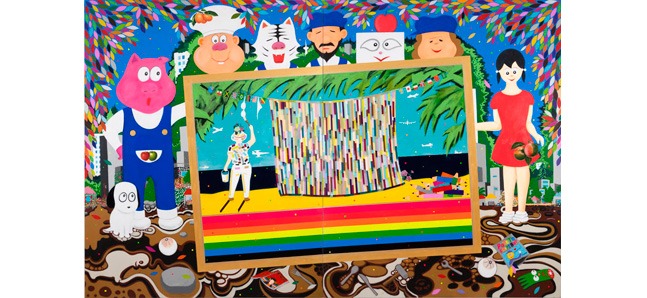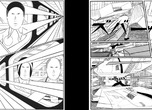Soju Tao: ‘Bonnie the Dog’
Entertaining others through art comes from being the youngest

Soju Tao ‘Bonnie the Dog’ (2010) /Courtesy the artist and Take Ninagawa, Tokyo
Posted: Wed Jun 09 2010
When we asked Soju Tao if he happens to be the youngest child in the family he responded with a grin, ‘Ah… yep, I’ve got three older sisters.’ We asked him this question at the opening party for Tao’s exhibition, ‘Bonnie the Dog’ at Take Ninagawa gallery in Azabu Juban, where we got a glimpse what it means to be the youngest.
Tao is an emerging artist who has been gaining attention both in Japan and abroad, having been selected in 2008 by artist Sophie Calle to participate in the ‘Chanel Mobile Art’ exhibition. For that exhibition, Tao created an installation featuring a Chanel bag bought straight from its owner on the street, along with which he displayed his own paintings and other items. This work, which was exhibited in Chanel’s Omotesando store, appeared playful and innocent, but it also had a mean spirited quality to it. Tao put this project together under the name of his fictional production company, Okame Pro, a fictitious organisation that, as an artistic method, represent the the artwork of characters such as Kiss Boy.
‘Bonnie the Dog’ tells the much-examined story of an owner and their dog, with the feel of the black and white cartoons and films from America’s good old days. The archetypes are all there: the central character of the baby-faced factory worker, an incident with a dog that gets in trouble for leaving a mess in the garden, the father who becomes a prize fighter to make money and the ‘mother who disappears on the back of a young man’s bike.’
The over 40 works are displayed in random order, with each work a self-contained story told through words and pictures; each piece has no logical connection to the other work, leaving the viewer free to follow them in any order.
The very round shape of the characters and the text such as in ‘Boku no machi niwa umi ga mieru yo’ (‘You can see the sea in my town’) give the pictures a certain picture book quality. The works have a catchy friendliness with a hint of mischievousness (which recalls his earlier work); a cheerful energy which must bring enjoyment to Tao himself, in addition to his audience.
While being the artist – the author of the pictures, so to speak –Tao makes cameo appearances in them, too. However, when he suddenly appears out of the blue as a foreigner (most likely pretending to be an American), with Hangul characters written across his chest it’s not hard to think that it might not be Tao after all.
The viewer, however, can put these thoughts aside. The role of this fictional artist is to tell the viewer that ‘The show is over for Bonnie the Dog.’ While the dog dies in the end, it’s Tao who is drawing the curtain on himself through each of his artworks. Rather than the fictitious characters of the dog and the artist representing Tao’s alter-ego, it seems more like that they are ‘database-derived characters,’ a theory espoused by Hiroki Azuma. In the case of Tao, though, it’s not the society around him from which he gets his ideas, but more likely the scenes that he has been creating since being a young child. The representation of Tao dying slowly comes, arguably, from a child who mimics one thing after another in order to entertain others rather than being some manifestation of a childhood complex.
And as such, we decided to ask Tao if he was the youngest child in the family right at the outset. It’s the youngest child in a family (and especially in the case where there are older female siblings) that most often tries to entertain those around themselves (inevitably the grown-ups.) They learn how to make fun for themselves when no one is paying attention to them, and they also have to decide for themselves when to stop playing – and it could be very much the case for Tao.
One could even say that this kind of youthful enthusiasm is a product of the noughties’ generation. Tao is not just repeatedly showing us the self-sufficiency he developed from being the youngest child; don’t forget that as we mentioned earlier he also uses various other representations through Okame Pro. The current appeal of his work is that he gives a voice to his ideas not just under his own name, but also through his various other characters.
Soju Tao: ‘Bonnie the Dog’
Date: Until Sat June 19
Location: Take Ninagawa Gallery (Full details & map)
Tweets
- About Us |
- Work for Time Out |
- Send us info |
- Advertising |
- Mobile edition |
- Terms & Conditions |
- Privacy policy |
- Contact Us
Copyright © 2014 Time Out Tokyo














Add your comment